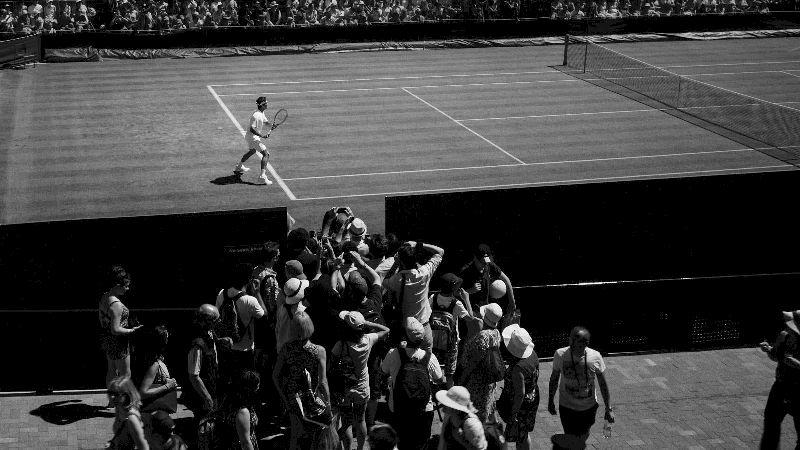
Photo by Howard Bouchevereau on Unsplash
Study finds that the sport of tennis critically depends on information and communication technology
While over five lakh people reportedly attended the Wimbledon Championships, one of the biggest tennis tournaments, in 2019, the videos of the game clocked around 380 million views online. Robotic cameras and virtual interview rooms were set up at the venue. Tennis matches no longer involve only the people at the stadium. Technology has made its presence felt alongside the players, coaches, referees, ball-fetchers, organisers and fans. Besides, with the growth of social media, each move on the court is watched, scrutinised and analysed by people across the world.
Digital platforms, social media, and other technologies that enable virtual interactions — termed as information and communication technology (ICT) — have become an integral part of sports such as tennis. A recent study by a team of researchers, led by Dr Vidya Balasubraminan from the Indian Institute of Technology Bombay (IIT Bombay) and Dr Marianne Noel of the Institut Francilien Recherche Innovation Société (IFRIS) in France, has found that ICT is not merely a passive part of the game. It shapes the lives of the people involved and the economy surrounding it. The study was supported by IFRIS.
“Technology has become an invisible layer on top of almost everything we do in life,” says Dr Subramanian. “It is, therefore, essential to study it, to render it visible and understand the effect it has on our lives — collectively and individually.”
Social media platforms such as Facebook and Twitter are usually abuzz with conversations about matches, tournaments, events, and players during tennis play-offs. The researchers of the current study found a similar trend among sports fans in India who use WhatsApp groups to discuss the matches. Businesses leverage the engagement of a large number of users over these platforms to sell their brand and advertise products. This, in turn, drives the funding of the infrastructure, the organisers of gala events, and the players themselves. Tennis is not just entertainment but a thriving economy running on technology.
The researchers investigated how the experience of bigger tennis tournaments are shaped by technology during their visit to the French Open 2017 at Stade Roland Garros, Paris. They found that technology actively drove every aspect of the visit, starting from the online ticketing system, to wristbands equipped with radio-frequency identification (RFID) chips to track visitors, and to the way the game is played.
Players rely heavily on technology to improve their performance on court through improved rackets and shoes and in training including physiotherapy. During the matches, with the adaptation of a ball-tracking technology called ‘Hawk-Eye’ on the court, umpiring technology has arguably been freed of glaring errors. But, the technology is not foolproof and has given rise to its share of controversies.
The researchers found that the entire viewer experience of their visit was immersed in technology, confronted with multiple screens across the arena showing the games, scorecards and countdowns to the next event. They noticed the extent of spaces used for advertising; even the umpire’s seat was not spared. Advertisements featuring local tennis stars were used to tap into the visitors’ love for tennis.
The organisers provided special-purpose apps that would purportedly ease the visit, and visitors could even avail sponsored solar-powered stations to charge their phones. The venue also featured a virtual reality world, sponsored by various brands, where visitors could answer quizzes, upload their selfies or use Holotennis to play tennis through their virtual avatars.
By going through various social media channels, the team found that most of the top-ranked tennis players use popular social media channels like Twitter, Facebook, and Instagram to stay connected with the organisers and fans. In many of their tweets during the Australian Open in 2016, the stars used their popularity to promote brands they represent.
“The players offer their opinion, behind-the-scenes information and share photos that wouldn’t otherwise make it to the press,” says Dr Subramanian, about how the tennis stars engage on Twitter. “The social media feeds of several players themselves become news.”
Now that only a few clicks separate the stars and fans, the boundaries between the public and private lives of players have also blurred. Intense negative and personal attacks on the players on social media, sometimes based on results of games, have led to trauma and even depression for players who later quit the sport.
The study concludes that technology drives the sport, and even the players are mere cogs in the wheel that is the economy. “It would benefit both sportspersons and the spectators if technological interventions in sport — any sport — are made deliberately and with adequate forethought rather than simply as defaults that just ‘happened’,” says Dr Subramanian.
Further, the researchers believe that not enough studies have been conducted on how technology has shaped the organisational aspects of the game, including the organising bodies which set the rules of the sport.
“Within India, there is a lot of scope for study into the administration and inner workings of all sports, especially cricket,” adds Dr Subramanian. “As more and more of sport becomes datafied and technology-mediated, sport policy and sports administration should look more consciously at how technology becomes embedded in sport,” she signs off.






